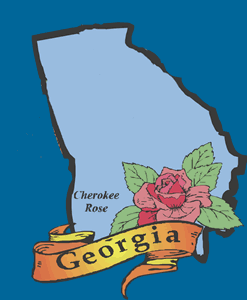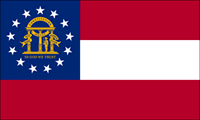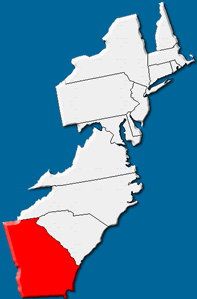 History:
The first European to enter the Georgia Region was Spanish explorer Hernando de Soto in 1540. A French colony was established a few years later, but this angered King Philip I of Spain. In 1565, the Spanish drove the French out. The Spanish later established several forts along the Atlantic Coast.
England also claimed this area. Charles I of England included the Georgia Region in a colonial land grant in 1629. By 1730, a group of Englishmen had developed a plan for establishing a British colony in the area. It was to be called "Georgia" in honor of King George II. They hoped to use the colony as a place to send British citizens who had failed to pay their debts, but the idea was soon abandoned.
Despite protests by the Spanish, Englishman James Edward Oglethorpe, along with a group of settlers, arrived in 1733 at the site of present-day Savannah. They were part of a 21-year long charter for the new colony that had been granted by King George to a British Corporation known as the Trustees for Establishing the Colony of Georgia. During that span of time, more than 4,000 settlers entered Georgia, at least half of them at the expense of the Trustees. Georgia was the last of the original thirteen colonies to be founded.
The Spanish became increasingly upset by the presence of the British. In 1739, a war broke out between England and Spain. James Oglethorpe successfully defeated the Spanish at the Battle of Bloody Marsh on St. Simons Island in 1742. This brought an end to the struggle over control of the Georgia Region. A year later, Oglethorpe left for England, never to return to the New World.
Soon the desire to be independent from Great Britain spread to the Georgia colony. After the American Revolution began in Massachusetts in 1775, many Georgians banded together and seized power from the colony's British-appointed governor, James Wright. Georgia declared independence from Britain in 1776.
But some Georgians remained loyal to the British crown. During this period, fighting occurred not only between American and British forces, but between the citizens of Georgia.
The first major Revolutionary War battle on Georgia soil was fought in December of 1778 when Savannah was captured by British troops. The British had seized all of Georgia by 1779, but they were driven out of the state by 1782. The American Revolution ended in 1783. Georgia had suffered much destruction and the loss of many lives.
In 1788, Georgia became the fourth state to ratify the Articles of Confederation, the forerunner to the United States Constitution.
During the 1800s, Georgia experienced great growth. The development of the cotton gin by Eli Whitney in 1793 resulted in the expansion of cotton farming within the state. Settlers and land companies began developing Georgia rapidly during this time. The Federal Government promised to help Georgia remove the Native Americans from its land. The government purchased land from the Cherokee and Creek Indians, forcing them to leave the state. The former Indian lands were quickly cleared and cotton farms were established.
The economy of Georgia was based on cotton. Cotton farms depended heavily on slave labor. In 1860, after the election of President Abraham Lincoln, who opposed the institution of slavery, the governor of Georgia, Joseph Brown, led his state in a movement to secede from the Union. On January 19, 1861, Georgia became the 5th state to withdraw from the Union. Georgia joined the Confederate States of America a few months later and the Civil War began in April of that year.
Although the Confederates won the first major battle in George - the Battle of Chickamauga in September of 1863 - the state suffered devastating losses the next year. Union General William Tecumseh Sherman captured the city of Atlanta, and then continued on his famous "March to the Sea." Along the way, Sherman and his troops plundered farms and homes, and destroyed factories, mills, buildings, and railroads. The city of Savannah was captured in December of 1864, and the Civil War came to an end the following April. |










 Andersonville was one of the largest of the Confederate military prisons established during the Civil War. It was built early in 1864. More than 45,000 Union soldiers were confined here. Almost 13,000 men died from disease, malnutrition, overcrowding, or exposure to the elements. Today, it serves as a memorial to all American prisoners of war.
Andersonville was one of the largest of the Confederate military prisons established during the Civil War. It was built early in 1864. More than 45,000 Union soldiers were confined here. Almost 13,000 men died from disease, malnutrition, overcrowding, or exposure to the elements. Today, it serves as a memorial to all American prisoners of war.